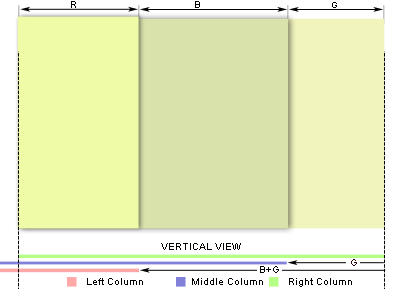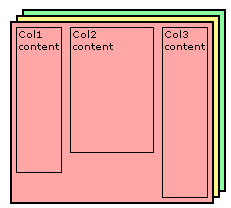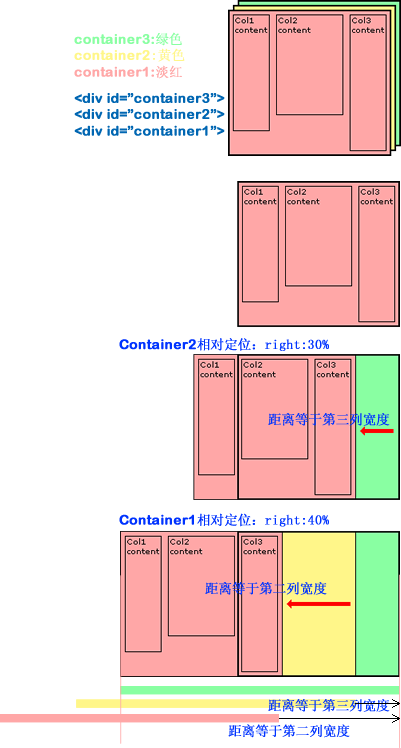高度相等列在Web页面设计中永远是一个网页设计师的需求。如果所有列都有相同的背景色,高度相等还是不相等都无关紧要,因为你只要在这些列的父元素中设置一个背景色就可以了。但是,如果一个或多个列需要单独设置自己的背景色,那么它的视觉完整性的设计就显得非常重要了。大家都知道当初Table实现等高列布局是多么的简单,但是我们使用CSS来创建等高列布局并非是那么容易的事情。
如果一个设计是固定宽度(非流体的宽度设计),那么实现多列等高效果是相当的容易。最好的技术就是使用Dan Cederholm的Faux Columns技术。只要制作一张合适的背景图片,在你多列的父元素中进行垂直铺放,从而达到一种假像(假的多列等高布局效果)。但是在流体布局中要用CSS实现多列等高的设计那就不是那么容易的事情,因为我们没有办法在使用背景图片来实现多列等高的假像了,那么是不是就没有办法实现了呢?那当然不是那么回事了,不管是实现固定布局还是流体布局的等多列等高视觉效果,方法还是蛮多的,这些方法体现了CSS的不同技术,也各有千秋,下面我们就一起来探讨Web页面中的多列等高的实现技术。
下面要介绍的方法都是让我们的布局如何实现多列的等高视觉效果,正如下图所示:

一、假等高列
这种方法是我们实现等高列最早使用的一种方法,就是使用背景图片,在列的父元素上使用这个背景图进行Y轴的铺放,从而实现一种等高列的假像:
Html Markup
<div class=”container clearfix”> <div class=”left”></div> <div class=”content”></div> <div class=”right”></div> </div>
在制作样式之前需要一张类似下面的背景图:
CSS Code:
.container { background: url("column.png") repeat-y; width: 960px; margin: 0 auto; } .left { float: left; width: 220px; } .content { float: left; width: 480px; } .right { float:left; width: 220px; }
优点:
实现方法简单,兼容性强,不需要太多的css样式就可以轻松实现。
缺点:
使用这种方法不适合流体布局等高列的布局,另外如果你需要更换背景色或实现其他列数的等高列时,都需要重新制作过背景图。
二、给容器div使用单独的背景色(固定布局)
这种方法实现有点复杂,如果你理解其实现过程也是相当的简单。这种方法我们主要给每一列的背景设在单独的<div>元素上。这种方法的实现的原则是:任何<div>元素的最大高度来撑大其他的<div>容器高度。如下图所示:

上图中,不管我们哪一列的高度最高,那么其三个容器“rightBack,contentBack,leftBack”的高度相应会随最高列的高列变化,下面我们一起来看其实现过程:
Html Markup
<div class="container"> <div class="rightWrap"> <div class="contentWrap"> <div class="leftWrap"> <div class="aside column leftSidebar" id="left"></div> <div id="content" class="column section"></div> <div class="aside rightSidebat column" id="right"></div> </div> </div> </div> </div>
CSS Code:
<style type="text/css"> .container { width: 960px; margin: 0 auto; } .rightWrap { width: 100%; float: left; background: green; overflow: hidden; position: relative; } .contentWrap { float: left; background: orange; width: 100%; position: relative; right: 320px;/*此值等于rightSidebar的宽度*/ } .leftWrap{ width: 100%; background: lime; float:left; position: relative; right: 420px;/*此值等于Content的宽度*/ } #left { float: left; width: 220px; overflow: hidden; position: relative; left: 740px; } #content { float: left; width: 420px; overflow: hidden; position:relative; left: 740px; } #right { float: left; overflow: hidden; width: 320px; background: #333; position: relative; left: 740px; } </style>
看起来蛮复杂吧?其实你只要了解了它是如何的工作原理就会变得非常简单,你只要理解并掌握以下几点:
- “div.rightWrap”、“div.contentWrap”、“div.leftWrap”都是一个封闭的容器;而“div#left”、“div#content”、“div#right”就是我们所说的列,里面放了内容;
- 每一个容器对应一列的背景色(用来放置背景色或背景图片);此例对应的是:“div.rgithWrap”用来实现“div#right”列的背景色;“div.contentWrap”用来实现“div#content”列的背景色;“div.leftWrap”用来实现“div#left”列的背景色;
- 除了最外面的容器(也就是对应的最左列容器)外,我都都对他们进行相对定位,并且设置其“right”值,此值并和相对应的列宽相等。此例中“div.contentWrap”对应的刚好是“div#right”的宽度;而“div.leftWrap”对应用的刚好是“div#content”的宽度;
- 给每列进行左浮动,并设置其列宽
- 给每一列设置相对定位,并进行“left”设置,而且“left”的值等于除第一列的所有列宽的和。此例中“left”的值等于“div#right”和“div#content”两列的宽度之和,也就是320px+420=740px
用两幅图来展示其实现的过程:
下图是实现上面的第二步对应的示例图,也就是容器“div.rightWrap”,“div.contentWrap”,“div.leftWrap”进行相对定位(position: releative),并展示了如何设置对应的“right”值。

上图虚线代表的范围是可视范围,其中有两列背景将会溢出,解决这个只需要在最外层容器“div.rightWrap”加上“overflow:hidden”就可以进行隐藏溢出的其他背景色。接下来下图所展示的是上面所说的第五步:

前面我们对三个内容元素都进行了相对定位,现在只需要按第五步将其定位回去,如上图所示。其实说到最后,你只要理解了这两幅,你就什么都清楚了。
优点:
这种方法是不需要借助其他东西(javascript,背景图等),而是纯CSS和HTML实现的等高列布局,并且能兼容所有浏览器(包括IE6),并且可以很容易创建任意列数。
缺点:
这种方法不像其他方法一样简单明了,给你理解会带来一定难度,但是只要你理解清楚了,将能帮你创建任意列数的等高布局效果。
三、给容器div使用单独的背景色(流体布局)
这种布局可以说是就是第二种布局方法,只是这里是一种多列的流体等高列的布局方法。前面也说过了,其实现原理就是给每一列添加相对应用的容器,并进行相互嵌套,并在每个容器中设置背景色。这里需要提醒大家你有多少列就需要多少个容器,比如说我们说的三列,那么你就需要使用三个容器。如下图所示:

HTML Markup
<div id="container3"> <div id="container2"> <div id="container1"> <div id="col1">Column 1</div> <div id="col2">Column 2</div> <div id="col3">Column 3</div> </div> </div> </div>
CSS Code:
<style type="text/css"> #container3 { float: left; width: 100%; background: green;/**/ overflow: hidden; position: relative; } #container2 { float: left; width: 100%; background: yellow; position: relative; right: 30%; /*大小等于col3的宽度*/ } #container1 { float: left; width: 100%; background: orange; position: relative; right: 40%;/*大小等于col2的宽度*/ } #col1 { float:left; width:26%;/*增加了2%的padding,所以宽度减少4%*/ position: relative; left: 72%;/*距左边呀增加2%就成72%*/ overflow: hidden; } #col2 { float:left; width:36%;/*增加了2%的padding,所以宽度减少4%*/ position: relative; left: 76%;/*距左边有三个padding为2%,所以距离变成76%*/ overflow: hidden; } #col3 { float:left; width:26%;/*增加了2%的padding,所以宽度减少4%*/ position: relative; left: 80%;/*距左边5个padding为2%,所以距离变成80%*/ overflow: hidden; } </style>
上面展示的是三列的,下面我们在来看一下两列和更多列的模板:
两列的HTML Markup:
<div id="container2"> <div id="container1"> <div id="col1">Column 1</div> <div id="col2">Column 2</div> </div> </div>
两列的CSS Code:
<style type="text/css"> #container2 { float: left; width: 100%; background: orange; position: relative; overflow: hidden; } #container1 { float: left; width: 100%; background: green; position: relative; right: 30%; } #col1 { width: 66%; float: left; position: relative; left: 32%; } #col2 { width: 26%; float: left; position: relative; left: 36%; } </style>
四列的HTML Markup:
<div id="container4"> <div id="container3"> <div id="container2"> <div id="container1"> <div id="col1">col1</div> <div id="col2">col2</div> <div id="col3">col3</div> <div id="col4">col4</div> </div> </div> </div> </div>
四列的CSS Code:
<style type="text/css"> #container4 { float: left; width: 100%; background: green; position: relative; overflow: hidden; } #container3 { float: left; width: 100%; background: #B2F0F9; position: relative; right: 20%;/*此值等于col4的宽度*/ } #container2 { float: left; width: 100%; background: #89FFA2; position: relative; right: 30%;/*此值等于col3的宽度*/ } #container1 { float: left; width: 100%; background: #369; position: relative; right: 30%;/*此值等于col2的宽度*/ } #col1 { width: 18%;/*1%的padding*/ float: left; position: relative; left: 81%; overflow: hidden; } #col2 { float: left; width: 28%; position: relative; left: 83%; overflow: hidden; } #col3 { float: left; width: 28%; position: relative; left: 85%; overflow: hidden; } #col4 { float: left; width: 18%; position: relative; left: 87%; overflow: hidden; } </style>
下面来看其实现过程,如果你理解了第二制作方法,那么这个你不用想一下就知道他们是一样的道理,如果你对第二种方法还不够清楚,那么你接着看这下面的内容,你会更清楚他们是怎么一回事的。下面我们一起来看三列的实现过程:
上图展示了,我们有三列,并且也说过了,这三列内容都放在了三个容器的div中,我们每一列的背景色不是放在内容列中,而是放置在容器中,现在我们需要通过对容器进行相对定位,把背景显示出来,而且我们这个容器是最外层的不能进行相对定位的移动,具体的请看下图:

上面我们把容器进行了相对定位,这样一来,我们内容也相应的做了移动,现在我们需要对页面列的内容也进行相对定位,并把内容和容器进行相反方向的定位,这样内容和容器背景色就能对应上了,请看下图所展示的:

接下来我们需要把溢出的部分切掉去,和前面一相,在最外面的容器加上overflow:hidden;这样就OK了。
最后为了让你的效果更加好看一点,你可以尝试给他们加上padding,比如说每列加上2%的padding值,具体实现可以简单从下图中得到:

优点:
兼容各浏览器,可以制作流体等高列,交无列数限制。
缺点:
标签使用较多,结构过于复杂,不易于理解,不过你掌握了其原理也就不难了,这也不算太大缺点。
三、创建带边框的现列等高布局
平常在制作中,我们需要制作两列的等高效果,并且有一条边框效果,那么这个实例我们就一起来看其实现方法:
Html Code
<div id="wrapper"> <div id="sidebar"> ..... </div> <div id="main"> .... </div> </div>
CSS Code:
<style type="text/css"> html { background: #45473f; height: auto; } body { width: 960px; margin: 20px auto; background: #ffe3a6; border: 1px solid #efefef; } #wrapper { display: inline-block; border-left: 200px solid #d4c376; position: relative; vertical-align: bottom; } #sidebar { float: left; width: 200px; margin-left: -200px; margin-right: -1px; border-right: 1px solid #888; position: relative; } #main { float: left; border-left: 1px solid #888; } #maing, #sidebar{ padding-bottom: 2em; } </style>
优点:
可以制作带有边框的两列等高布局,并能兼容所有浏览器,结构简单明了。
缺点:
不适合于更多列的应用,比如说三列以上,这样的方法就行不通了。
四、使用正padding和负margin对冲实现多列布局方法
这种方法很简单,就是在所有列中使用正的上、下padding和负的上、下margin,并在所有列外面加上一个容器,并设置overflow:hiden把溢出背景切掉。下面一起来看代码:
HTML Markup:
<div id="container"> <div id="left" class="column aside"> <p>Sidebar</p> </div> <div id="content" class="column section"> <p>Main content</p> </div> <div id="right" class="column aside"> <p>Sidebar</p> </div> </div>
CSS Code:
<style type="text/css"> #container { margin: 0 auto; overflow: hidden; width: 960px; } .column { background: #ccc; float: left; width: 200px; margin-right: 5px; margin-bottom: -99999px; padding-bottom: 99999px; } #content { background: #eee; } #right { float: right; margin-right: 0; } </style>
优点:
这种可能实现多列等高布局,并且也能实现列与列之间分隔线效果,结构简单,兼容所有浏览器
缺点:
这种方法存在一个很大的缺陷,那就是如果要实现每列四周有边框效果,那么每列的底部(或顶部)将无法有边框效果。
下面我们就针对这个缺陷来介绍两种解决办法,第一种是使用背景图来模仿底部(或顶部)边框;第二种方法是使用div来模仿列的边框,下面我们来看这两种方法:
1、背景图模仿边框效果:
Html Code:
<div id="containerOuter"> <div id="containerInner"> <div id="left" class="column aside"> <p>Sidebar</p> </div> <div id="content" class="column section"> <p>Main content</p> </div> <div id="right" class="column aside"> <p>Sidebar</p> </div> </div> </div>
CSS Code:
<style type="text/css"> #containerOuter { background: url("images/bg.gif") no-repeat center bottom; width: 616px; margin: 0 auto; padding-bottom: 1px; overflow: hidden; } #containerInner { float: left; overflow: hidden; margin-right: -5px; } .column { background: #ccc; border: 1px solid #000; float: left; width: 200px; margin-right: 5px; margin-bottom: -99999px; padding-bottom: 99999px; } #content { background: #eee; } </style>
这种方法我们需要在外面增加一个层,并将背景图放置在这个层的底部,而且需要制作一张和列边框色一致,并且要先排列好他们之间的间距,如下图所示:
![]()
这种方法有一个最大的不足之处就是,如果我们更改了列的边框的颜色,或者改变了他们之间的间距,都需要重新制作过一张背景图来重新模仿这样的效果,下面一起来看看这种方法带来的最后效果:

2、使用div来模仿列的边框
我们这种方法是在列里面添加一个div,用这个div来模仿边框的效果,具体看代码吧:
Html Code:
<div class="wrapper"> <div class="container"> <div class="col1"> <div class="colBottom1"><!-- ie needs this comment for small div heights --></div> </div> <div class="col2"> <div class="colBottom2"><!-- ie needs this comment for small div heights --></div> </div> </div> </div>
CSS Code:
<style type="text/css"> .wrapper { width: 960px; margin: 0 auto; } .container { position: relative; overflow: hidden; zoom: 1; } /* zoom fix for ie6 */ .col1 { float: left; width: 728px; padding-bottom: 32767px; margin-bottom: -32767px; border: #f36 1px solid; background: #AFAFAF; } .col2 { float: right; width: 208px; padding-bottom: 32767px; margin-bottom: -32767px; border: #f36 1px solid; background: #6F6F6F; } .colBottom1 { position: absolute; /*相对于div.container*/ bottom: 0; left: 0px;/*如果第一列左浮动就设置left:0;*/ height: 1px; /*当前列的边框宽度*/ width: 730px;/*当前列宽度+边框宽度*2 */ background: #f36;/*当前列的边框颜色*/ } .colBottom2 { position: absolute; /*相对于div.container*/ bottom: 0; right: 0px; /*如果第二列右浮动就设置left:0;*/ height: 1px; /*当前列的边框宽度*/ width: 210px; /*当前列宽度+边框宽度*2 */ background: #f36;/*当前列的边框颜色*/ } </style>
五、使用边框和定位模拟列等高
这种方法是使用边框和绝对定位来实现一个假的高度相等列的效果。假设你需要实现一个两列等高布局,侧栏高度要和主内容高度相等。如:
Html Code:
<div id="wrapper"> <div id="mainContent">...</div> <div id="sidebar">...</div> </div>
CSS Code:
<style type="text/css"> #wrapper { width: 960px; margin: 0 auto; } #mainContent { border-right: 220px solid #dfdfdf; position: absolute; width: 740px; } #sidebar { background: #dfdfdf; margin-left: 740px; position: absolute; width: 220px; } </style>
优点:
结构简单,兼容各浏览器,容易掌握。
缺点:
这个方法就是无法单独给主内容列设置背景色,并且实现多列效果效果不佳。
六、边框模仿等高列
第五种方法我们无法实现主列的背景色设置,针对上面方法,稍作一下改良,这样就可以实现主内容也设置颜色的效果了
CSS Html:
<div id="container"> <div id="content">This is<br />some content</div> <div id="right">This is the right</div> </div>
CSS Code:
<style type="text/css"> #container{ background-color:#0ff; overflow:hidden; width:960px; margin: 0 auto; } #content{ background-color:#0ff; width:740px; border-right:220px solid #f00; /* 边框大小和颜色设置和right大小与颜色一样 */ margin-right:-220px; /*此负边距大小与right边栏宽度一样*/ float:left; } #right{ background-color:#f00; width:220px; float:left; } </style>
下面我们在此基础上改变流体布局:
HTML Markup
<div id="container"> <div id="content">Main content section</div> <div id="sidebar">Right Sidebar </div> </div>
<style type="text/css"> #container{ background-color:#0ff; overflow:hidden; margin:0 100px; padding-right:220px; /* 宽度大小等与边栏宽度大小*/ } * html #container{ height:1%; /* So IE plays nice */ } #content{ background-color:#0ff; width:100%; border-right:220px solid #f00; margin-right:-220px; float:left; } #sidebar{ background-color:#f00; width:220px; float:left; margin-right:-220px; } </style>
上面主要展示了这种方法的二列布局,下面我们在来看看三列布局的用法
HTML Markup
<div id="containerOuter"> <div id="container"> <div id="content">Main content section</div> <div id="left">LEFT sidebar</div> <div id="right">RIGHT sidebar</div> </div> </div>
CSS Code:
<style type="text/css"> #containerOuter { margin: 0 auto; width: 960px; } #container{ background-color:#0ff; float:left; width:520px; border-left:220px solid #0f0; /* 边框大小等于左边栏宽度,颜色和左边栏背景色一致*/ border-right:220px solid #f00;/* 边框大小等于右边栏宽度,颜色和右边栏背景色一致*/ } #left{ float:left; width:220px; margin-left:-220px; position:relative; } #content{ float:left; width:520px; margin-right:-520px; } #right{ float:right; width:220px; margin-right:-220px; position:relative; } </style>
接着在看一个三列自适应布局
Html Markup
<div id="container"> <div id="content">Main Content</div> <div id="left">Left Sidebar</div> <div id="right">Right Sidebar</div> </div>
CSS Code
<style type="text/css"> body{ margin:0 100px; padding:0 220px 0 220px; } #container{ background-color:#0ff; float:left; width:100%; border-left:220px solid #0f0; border-right:220px solid #f00; margin-left:-220px; margin-right:-220px; display:inline; /* So IE plays nice */ } #left{ float:left; width:220px; margin-left:-220px; position:relative; } #content{ float:left; width:100%; margin-right:-100%; } #right{ float:right; width:220px; margin-right:-220px; position:relative; } </style>
优点:
能兼容所有浏览器效果,结构简单明了,容易掌握。
缺点:
列数受到极限,超过三列不好控制。
七、模仿表格布局实列等高列效果
这种方法只适合现代浏览器,本不想介绍的,不过还是顺便列出让大家参考一下吧:
HTML Markup:
<div class="container table"> <div class="containerInner tableRow"> <div class="column tableCell cell1"> <div class="left aside"> .... </div> </div> <div class="column tableCell cell2"> <div class="content section"> ... </div> </div> <div class="column tableCell cell3"> <div class="right aside"> ... </div> </div> </div> </div>
CSS Code:
<style type="text/css"> .table { width: auto; min-width: 1000px; margin: 0 auto; padding: 0; display:table; } .tableRow { display: table-row; } .tableCell { display: table-cell; width: 33%; } .cell1 { background: #f00; } .cell2 { background: #0f0; } .cell3 { background: #00f; } </style>
优点:
这是一种非常简单,易于实现的方法。
缺点:
兼容性不好,在ie6-7无法正常运行。
八、jQuery和javascript大法
最后要给大家介绍的是使用jQuery和javascript方法来实现多列的布局效果。
1、jQuery实现方法:
Html Markup
<div class="container"> <div id="left" class="aside leftSidebar"></div> <div id="content" class="section"></div> <div id="right" class="aside rightSidebar"></div> </div>
CSS Code:
<style type="text/css"> .contanier { width: 960px; margin: 0 auto; } .aside, .section { float:left; width: 33%; background: lime; } .leftSidebar {background: orange;} .section { background: green;} </style>
jQuery Code:
<script type="text/javascript"> $(document).ready(function(){ //等高列的小插件 function setEqualHeight(columns) { var tallestColumn = 0; columns.each(function(){ currentHeight = $(this).height(); if(currentHeight > tallestColumn) { tallestColumn = currentHeight; } }); columns.height(tallestColumn); } //调用写好的插件,基中“.container > div”是你需要实现的等高列 setEqualHeight($(".container > div")); }); </script>
你也可以把上面的jQuery代码换成下面的
<script type="text/javascript"> $(document).ready(function(){ var currentTallest = 0, currentRowStart = 0, rowDivs = new Array(), $el, topPosition = 0; $('.column').each(function() { $el = $(this); topPostion = $el.position().top; if (currentRowStart != topPostion) { // we just came to a new row. Set all the heights on the completed row for (currentDiv = 0 ; currentDiv < rowDivs.length ; currentDiv++) { rowDivs[currentDiv].height(currentTallest); } // set the variables for the new row rowDivs.length = 0; // empty the array currentRowStart = topPostion; currentTallest = $el.height(); rowDivs.push($el); } else { // another div on the current row. Add it to the list and check if it's taller rowDivs.push($el); currentTallest = (currentTallest < $el.height()) ? ($el.height()) : (currentTallest); } // do the last row for (currentDiv = 0 ; currentDiv < rowDivs.length ; currentDiv++) { rowDivs[currentDiv].height(currentTallest); } }); }); </script>
如果你使用上面这个jQuery代码,你需要在需要实现等高列的div中加上"column"类名,这样才会有效果的。
2、JavaScript方法
上面是jQuery的实现方法,接下来看看javaScript的实现方法:
Html Markup:
<div class="contanier"> <div class="column" id="left"></div> <div id="content" class="column"></div> <div id="right" class="column"></div> </div>
CSS Code:
<style type="text/css"> .contanier { width: 960px; margin: 0 auto; } #left { width: 220px; float: left; margin-right: 20px; background: green; } #content { width: 480px; float: left; margin-right: 20px; background: lime; } #right { width: 220px; float: right; background: orange; } </style>
Javascript Code:
<script type="text/javascript"> function matchColumns(classname){ var divs,contDivs,maxHeight,divHeight,d; // get all <div> elements in the document divs=document.getElementsByTagName('div'); contDivs=[]; // initialize maximum height value maxHeight=0; // iterate over all <div> elements in the document for(var i=0;i<divs.length;i++){ // make collection with <div> elements with class attribute 'container' if(new RegExp("\\b" + classname + "\\b").test(divs[i].className)){ d=divs[i]; contDivs[contDivs.length]=d; // determine height for <div> element if(d.offsetHeight){ divHeight=d.offsetHeight; } else if(d.style.pixelHeight){ divHeight=d.style.pixelHeight; } // calculate maximum height maxHeight=Math.max(maxHeight,divHeight); } } // assign maximum height value to all of container <div> elements for(var i=0;i<contDivs.length;i++){ contDivs[i].style.height=maxHeight + "px"; } } // Runs the script when page loads window.onload=function(){ if(document.getElementsByTagName){ matchColumns('column'); // class=maincolumn } } </script>
上面八大种方法就是我今天要跟大家一起分享的等高列的布局方法,他们之间更有千秋,希望能给需要的您带来一定的帮助。篇幅过长,慢慢看吧,上面的代码都是经过测试的,兼容各大浏览器,可以直接复制代码使用。







相关推荐
大家都知道当初Table实现等高列布局是多么的简单,但是我们使用CSS来创建等高列布局并非是那么容易的事情。 如果一个设计是固定宽度(非流体的宽度设计),那么实现多列等高效果是相当的容易。最好的技术就是使用Dan...
根据提供的文件内容,我们可以解析出以下的CSS布局知识点: 1. 固定宽度与自适应宽度布局:...此外,文件中提及的《八种创建等高列布局》是一个学习资源,作者可能建议读者查看该资源以获得更深入的等高布局实现方法。
8. **Flexbox布局**:现代CSS布局模型,可以轻松实现灵活的一维布局,如主-侧栏布局、等高列布局等。 9. **Grid布局**:CSS Grid布局提供了一种二维布局方式,适合创建复杂的网格系统,如杂志风格的布局。 通过...
这种方法常用于创建等高列布局,如“圣杯布局”或“双飞翼布局”。 9. **CSS Grid 和 Flexbox 结合** 结合Grid和Flexbox的优势,可以创建更复杂的自适应布局。例如,使用Grid进行大范围的布局规划,然后在每个...
在本例中,可以推测文档中涉及了如何使用CSS中的`float`属性进行布局,如何清除浮动以及创建等高列等高级布局技术。 由于文件中使用的是京东这一知名电商平台的布局来作为练习案例,我们可以进一步分析京东网页布局...
负边距可以用来创造一些特殊布局效果,例如创建等高列布局。而坍塌边距是指在某些情况下,相邻块级元素的顶部和底部外边距可以合并,这在处理元素间距时需要特别注意。 总的来说,学习CSS布局需要理解元素的默认...
Flexbox(弹性盒模型)是现代CSS布局的一种方式,它解决了传统布局中的许多问题,如垂直居中、等宽/高列等。通过设置`display: flex`,可以轻松调整容器内子元素的排列、对齐和分配空间。 三、Grid布局 CSS Grid...
书中还介绍了一些实际场景下的布局技巧,比如如何创建等高列布局以及如何实现响应式网格系统。 接着,CSS揭秘探讨了视觉效果的创造,比如如何利用CSS来实现各种图形和动画效果。这包括了对SVG的运用,以及如何通过...
5. **列高度自适应**:如Faux Columns技术,利用背景图片实现等高列布局,解决不同内容量时列高度不一致的问题。 四、优化技巧: 1. **选择器优化**:避免使用过于复杂的选择器,以减少解析时间。 2. **CSS重置**:...
Dlv通常指的是“Delivery”或者在某些上下文中可能是“Display Layer”或“Design Layer”,在这里可能是为了简化表示“等高布局”或“等高列”的设计模式。这种设计方法常用于创建视觉上平衡且响应式的网页或应用...
本文将详细讲解三种使用CSS实现多列等高布局的方法:弹性盒子布局(Flexbox)、表格单元格布局(Table-Cell)以及假等高列布局(Padding-Margin负值)。 1. **弹性盒子布局(Flexbox)** Flexbox是CSS3引入的一种...
5. **Bootstrap的等高列**: 如果你在项目中使用Bootstrap框架,可以利用它的`equal-height`类或者自定义CSS来实现三行等高。Bootstrap 4中,可以使用`row-eq-height`类,但在Bootstrap 5中,这个类已被移除,需要...
5. **Flexbox**:现代布局模型,用于创建灵活、响应式的布局,如自适应导航栏、等高列等。 6. **Grid布局**:一种更为强大的二维布局系统,适用于创建复杂的网页布局。 7. **过渡和动画**:通过CSS的transition和...
本文主要探讨一种利用CSS的`display`属性来模拟表格布局的方法,这种方法尤其适用于创建等高列的布局。具体来说,通过设置`display: table`、`display: table-row`和`display: table-cell`,我们可以让普通的div元素...
Flexbox特别适合创建导航菜单、卡片布局、等高列等。 最后,网格布局(Grid)是CSS3的另一大创新,它提供了二维布局的能力,让开发者能更精确地控制元素在行和列中的位置。通过设置容器的`display`属性为`grid`,...
- **等高列布局**:可以通过使用JavaScript、CSS Flexbox或CSS Grid来实现左右两列等高的效果,确保即使内容长度不同,两栏的高度也保持一致。 - **固定中栏宽度**:对于三栏布局,可以固定中间栏的宽度,而左右...
这种特性在某些情况下可以替代浮动布局,尤其是当需要创建等高列布局时,通过负的`margin-bottom`和`overflow:hidden`的组合,可以有效地调整元素的高度。 此外,负边距还可以用于解决特定布局问题,例如,当需要在...
第七,实现等高列布局。在多列布局中,确保所有列有相同的高度,可以提高页面的视觉一致性,这个函数通过遍历和比较列的高度来达到目的。 第八,调整字体大小。通过增加或减少HTML元素的`font-size`属性,可以创建...